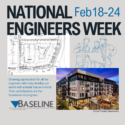Engineering Story of The Day
 “I was designing a hydraulic asphalt lined overflow pond for a sanitary sewer lift station. The pond area already existed as a decommissioned WWTP lagoon. It supposedly had a clay liner (found out from the geotech that it did not…). It had an old lift station that came on when the primary lift station went out. We were trying to expand the pond and eliminate the secondary lift station. No matter what I tried to do, I couldn’t eliminate the lift station due to grades. I presented this to my team and they asked why I still had a lift station. I told them I couldn’t get the grades to work. The treatment plant manager asked why we couldn’t surcharge the upstream manholes to get gravity to work. Needless to say, it worked like a charm. I raised the cone section out of the ground to prevent an SSO but it was just more about paranoia on my part, the grades worked well when we surcharged the manholes. The pond on the other hand was another animal. It was easy enough to grade everything out and provide enough storage. The challenge came during construction when we discovered massive ground water on the eastern side of the pond. The geotech did not discover this during pre-design. We think this happened for three reasons, 1) there was a vertical clay layer that kept the water back on the east side that did not present itself when we did the borings, 2) ground water came up significantly between when we did the borings and went to construction due to heavy rains for months preconstruction, 3) the sewer main allowed the rains to travel down the trench into where we over-excavated the bottom of the pond. Needless to say, we had to account for the new grade being compromised by groundwater. I field designed large riprap French drains that allowed us to divert enough groundwater under the recompacted pond. We also established two ground wells to pump and discharge water from the French drains. The one on the east was decommissioned just after construction. The one to the south of the pond is still in operation for two reasons. We kept it in continuous operation to prevent groundwater from compromising the asphalt bottom and the poly lining on the sides. Eventually, we brought up the floats on the pump gradually to stop it because the drains did their job and there was no longer a threat of side slope hydrostatic pressure. The pump and well remain in case the drains ever fail. These were just two major challenges in this project, but it was fun working on it and being up to the challenge.” — Kim Swearingen, PE, MBA, Colorado Springs Division Manager
“I was designing a hydraulic asphalt lined overflow pond for a sanitary sewer lift station. The pond area already existed as a decommissioned WWTP lagoon. It supposedly had a clay liner (found out from the geotech that it did not…). It had an old lift station that came on when the primary lift station went out. We were trying to expand the pond and eliminate the secondary lift station. No matter what I tried to do, I couldn’t eliminate the lift station due to grades. I presented this to my team and they asked why I still had a lift station. I told them I couldn’t get the grades to work. The treatment plant manager asked why we couldn’t surcharge the upstream manholes to get gravity to work. Needless to say, it worked like a charm. I raised the cone section out of the ground to prevent an SSO but it was just more about paranoia on my part, the grades worked well when we surcharged the manholes. The pond on the other hand was another animal. It was easy enough to grade everything out and provide enough storage. The challenge came during construction when we discovered massive ground water on the eastern side of the pond. The geotech did not discover this during pre-design. We think this happened for three reasons, 1) there was a vertical clay layer that kept the water back on the east side that did not present itself when we did the borings, 2) ground water came up significantly between when we did the borings and went to construction due to heavy rains for months preconstruction, 3) the sewer main allowed the rains to travel down the trench into where we over-excavated the bottom of the pond. Needless to say, we had to account for the new grade being compromised by groundwater. I field designed large riprap French drains that allowed us to divert enough groundwater under the recompacted pond. We also established two ground wells to pump and discharge water from the French drains. The one on the east was decommissioned just after construction. The one to the south of the pond is still in operation for two reasons. We kept it in continuous operation to prevent groundwater from compromising the asphalt bottom and the poly lining on the sides. Eventually, we brought up the floats on the pump gradually to stop it because the drains did their job and there was no longer a threat of side slope hydrostatic pressure. The pump and well remain in case the drains ever fail. These were just two major challenges in this project, but it was fun working on it and being up to the challenge.” — Kim Swearingen, PE, MBA, Colorado Springs Division Manager
 The First Professional Engineer in the US
The First Professional Engineer in the US
Before 1907, no states in the US required any formal proof that a worker or an employee had the necessary skills of an engineer. When Clarence Johnston took the position of Wyoming’s State Engineer in 1903, he soon realized that anyone would pose as an engineer to gain access to water rights for irrigation. To get these rights, developers needed to complete an application that included a map of the streams, canals, and reservoirs to be used for the proposed irrigation; this soon led to inaccurate reports and maps as anyone could submit the application – lawyers, notaries, and anyone else who wanted access to the water. Frustrated at the inaccuracies, Johnston and his team pushed for state legislation regulating who would be allowed to present themselves as engineers and land surveyors. In 1907, they presented a bill that would be signed into law the same year which created the first version of the professional engineer (PE) exam and the state board of examiners for the State of Wyoming!
The first PE ever to be licensed was 52-year-old Charles Bellamy of Laramie, WY — an engineer and mineral surveyor (photo courtesy of NSPE.org). After the success of Wyoming’s new law, more states followed suit. By 1920, 10 states, including Colorado, had state laws requiring engineers to have a professional license and all plans and drawings to have the stamp of a professional engineer. However, these licenses had one problem in that they could not be transferred between states meaning engineers would have to take different exams for every state they wanted to practice in. These frustrations led to the fall of 1920, when the Iowa State Board of Engineering Examiners called the other states with similar laws to meet and create one overarching exam for a professional engineering license. Seven out of the original 10 states responded and thus created the Council of State Boards of Engineering Examiners that eventually became the National Council of Examiners for Engineering and Surveying, which is the current governing body for the professional engineer exam. By 1950, all states required professional engineers to be licensed through an exam. However, it took until 1984 for all members of the NCEES to adopt a standardized test.
Interesting Facts About the PE Exam and Licensing
- Colorado was one of the first 10 states to introduce legislation that required licensing of professional engineers.
- The earliest license the State of Colorado has for a PE belongs to Gairald H Garrett, with a license number of 46. It was issued on February 18, 1920 in the City of Denver.
- Montana was the last state to require a professional examination.
- By 1950, all states required professional engineer to be licensed and required a test. However, it took until 1984 for all members of the NCEES to adopt a standardized test.
Excerpts from Baseline’s Engineer Team
National Engineers Week, celebrated annually during week of February around Presidents Day, dedicated to ensuing a diverse and well-educated future engineering workforce by increasing understanding of and interest in engineering and technology careers, this year’s event takes place February 16-22, 2020.
In honor of National Engineers Week, and the important role engineers have played in our firm’s success, we recently surveyed our infrastructure staff to learn more about the profession and their perspectives. Check out what our engineers had to say each day this week for their survey responses on why they chose this profession, what inspires them, and what advice can they offers others.
Why should someone consider a career as an engineer? In your opinion, what types of skills or traits are essential to have as an engineer?
“It’s amazingly rewarding to solve problems while being innovative and those solutions are a huge benefit to the community that you work in. As far as traits, attention to detail, patience, meticulous problem solving, and resourcefulness.” — John McLain, PE, CEO
“I think someone should consider a career in engineering because no matter what your specific interest is, there is probably a field of engineering for you. Civil engineering alone has civil, structural, soils, transportation, land development, and many more. I think civil engineering involves problem-solving that often requires being able to picture things three dimensionally. Being comfortable working with numbers and technology also helps.” — Mike Swanton, PE, Project Manager
“It’s one of the most rewarding careers out there. Not many people can drive by (or on) something going to work with the pride that they put that thing together on paper. Plus, I get to protect the things I care about most! Need traits include that you always need to be willing to learn. Mistakes will happen, to me what is important is how you recover and learn from them. I think you also need to be a little curious about everything. As engineers, we should always be questioning if there could be a better, safer, or more efficient way to go about a process. Keep asking questions and challenging others around you.” — Sean Callahan, EIT, Staff Engineer
“Engineering is a career where you can be responsible and take pride in your work. With civil engineering you’re able to actually see the projects in person. Engineers are trained in problem-solving, which is vital in designing projects as each project is different and poses new challenges. Effective communication skills are also very important in the consulting world as there are numerous client interactions, city meetings, and coordination aspects that require more than just a technical mind.” — Morgan Clapp, EIT, Project Engineer
“There are so many options in the field of engineering and an education in engineering is a great background even if you go on to other fields. One of the best things about being an engineer is that your projects benefit society. Problem-solving without a doubt is the most important skill for an engineer to have. As an engineer you need to define the problem, determine alternatives, evaluate and selecting a solution that is cost-effective and practical, then implementing that solution on your plans and in the field. It’s not a skill that is inherent to everyone and ideally, it’s a skill that good mechanics have when trying to diagnose what is wrong with your car, doctors when diagnosing an illness, and fire and law enforcement when evaluating an emergency situation. It’s really a skill that everyone should have, not just engineers.” — Noah Nemmers, PE, Civil Engineering Division Manager
“If they have a thirst for knowledge, want to have a variety of tasks, and can laugh at themselves, engineering is for them. To be a good engineer you have to have the technical skills for sure, but to be a success in your field, you have to be engaged and willing to put your heart into it. Passion, the drive to do your best, and make others better at the same time is a great reward. Since we are in the consulting field, we also have to have the essential skills (typically thought of as soft skills), these are skills not often thought of when discussing engineers. We have to talk to people, we have to be engaging, we have to convey technical subjects and hard to understand concepts to people that aren’t technical or don’t have time to be subject matter experts.” — Kim Swearingen, PE, MBA
“Between a variety of clients, projects, criteria, and constraints, your job is rarely the same day in and day out. Traits include quantitative and qualitative reasoning, analytic, creative, and confident.” — Chris Manning, PE, Water/Wastewater Division Manager
“It is a way for you to have a meaningful impact on your community. Engineer traits include thinking critically and creatively.” — Sarah Foster, PE, CFM, Project Engineer
“Someone should consider becoming and engineer because of the contribution to society. The best reason to become an engineer is to actual produce change in your community and influence the way people go about their daily lives. Proficient math and science skills are the obvious essentials. However, an engineer also has to play the role of a salesperson, a spokesperson, a manager, an accountant, and countless other subsequent skills that engineering jobs require.” — Zach Henrichs, PE, Project Engineer
“It is rewarding and fun. It helps to be naturally good at math and to have a natural ability to be able to understand criteria and apply it to individual projects, as no two projects are ever the same.” — Sarah Parsley, EIT, Project Engineer



